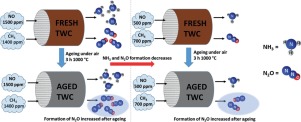Applied Catalysis A: General ( IF 4.7 ) Pub Date : 2017-12-24 , DOI: 10.1016/j.apcata.2017.12.017 Pauliina Nevalainen , Niko M. Kinnunen , Anna Kirveslahti , Kauko Kallinen , Teuvo Maunula , Matthew Keenan , Mika Suvanto

|
An increasing number of heavy-duty vehicles are using liquefied natural gas (LNG) as a fuel due to the expanding refuelling station network for LNG and lower overall emissions compared to diesel vehicles. The latest EURO VI regulation or natural gas fuelled vehicles set a limit for NH3 of 10 ppm, and N2O exhaust is expected to be restricted in Europe in the near future. Poisonous and corrosive NH3 and the greenhouse gas N2O are formed as by-products in a three-way catalyst used to minimize the emissions of stoichiometric heavy-duty engines. In this work, we studied how high temperature NH3 and N2O formed in modern, fresh and aged bimetallic Pd/Rh three-way catalysts in simulated exhaust gas. More precisely, the exhaust gas composition and temperature were examined. Decreases in NO concentration and increases in temperature lowered the formation of NH3 and N2O, whereas a decrease in CH4 concentration reduced only NH3 formation. According to Raman and powder X-ray diffraction experiments, the structure of the catalyst changed during the ageing, and this reputedly affected the function of cerium-zirconium mixed oxides and thus the formation of NH3 and N2O. Temperature programmed reduction (H2-TPR) measurements showed changes in cerium-zirconium mixed oxide performance after ageing supporting Raman spectroscopy findings. Catalyst ageing in oxidizing conditions increased the formation of N2O. This study showed that exhaust gas composition plays an important role in the formation of undesired NH3 and N2O emissions.
中文翻译:

专为重型车辆设计的现代天然气三元催化剂中NH 3和N 2 O的形成:模拟废气成分和老化的影响
由于使用液化天然气(LNG)的加油站网络不断扩大,并且与柴油车辆相比,总排放量降低,因此越来越多的重型车辆正在使用液化天然气(LNG)作为燃料。最新的EURO VI法规或以天然气为燃料的车辆将NH 3的限值设定为10 ppm,并且预计在不久的将来欧洲将限制N 2 O的排放。毒性和腐蚀性的NH 3和温室气体N 2 O在三效催化剂中作为副产物形成,用于最小化化学计量重型发动机的排放。在这项工作中,我们研究了高温下的NH 3和N 2在现代,新鲜和老化的双金属Pd / Rh三效催化剂中,在模拟废气中形成O。更精确地,检查排气成分和温度。NO浓度的降低和温度的升高降低了NH 3和N 2 O的形成,而CH 4浓度的降低仅减少了NH 3的形成。根据拉曼和粉末X射线衍射实验,催化剂的结构在老化过程中发生了变化,据说这会影响铈锆混合氧化物的功能,从而影响NH 3和N 2 O的形成。程序升温还原(H 2个-TPR)测量显示了老化后铈锆复合氧化物性能的变化,这有助于拉曼光谱学的发现。在氧化条件下催化剂老化会增加N 2 O的形成。这项研究表明,废气成分在不希望的NH 3和N 2 O排放物的形成中起着重要作用。











































 京公网安备 11010802027423号
京公网安备 11010802027423号